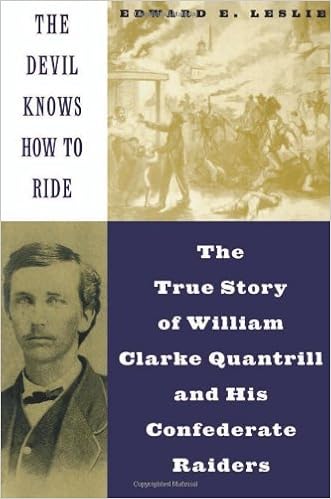
Free Downloads The Devil Knows How To Ride: The True Story Of William Clarke Quantril And His Confederate Raiders

Brilliantly weaving together eyewitness accounts, letters, memories, newspaper articles, and military reports into a riveting narrative, this definitive biography reveals the personality of William Clarke Quantrill (1837–1865) and the events that transformed a quiet Ohio schoolteacher from a staunchly Unionist family into a virulent pro-slavery Confederate soldier and the most feared and despised guerrilla chieftain of the Civil War. This groundbreaking work includes the most accurate account ever written of the 1863 Lawrence, Kansas massacre (the greatest atrocity of the Civil War), when Quantrill and 450 raiders torched the Unionist town and executed roughly 200 unarmed, unresisting men and teenage boys. It also details the postwar outlaw careers of those who rode with him—Frank and Jesse James, and Cole Younger. No other history so fully penetrates the myth of a cardboard-cutout psychopath to expose Quantrill in all his brutality and human complexity.

Paperback: 576 pages
Publisher: Da Capo Press (August 22, 1998)
Language: English
ISBN-10: 030680865X
ISBN-13: 978-0306808654
Product Dimensions: 6 x 1.4 x 9 inches
Shipping Weight: 2.1 pounds (View shipping rates and policies)
Average Customer Review: 4.5 out of 5 stars See all reviews (44 customer reviews)
Best Sellers Rank: #413,075 in Books (See Top 100 in Books) #187 in Books > History > Americas > United States > Civil War > Confederacy #434 in Books > Biographies & Memoirs > Historical > United States > Civil War #435 in Books > History > Americas > United States > Civil War > Campaigns & Battlefields

Leslie's grass roots research into the shadowy life of Civil War guerrilla chieftain William Quantrill has produced a vivid picture of the realities of life on the Missouri-Kansas frontier from the late 1850's until Quantrill's death in Kentucky in 1865 and has resulted in a book which will become the resource work in the field. Leslie spent years as a professional researcher doing background work for other authors writing on various topics, both fiction and non-fiction. Some of his research can be found in the works of James A. Michner, and others. Leslie knows how to dig out the facts of a story.On occasion, I accompanied him as he visited sites in both Missouri and Kansas where Quantrill stamped his name on the history of the War. I witnessed firsthand Leslie's feel for the subject material and his expertise and passion for fact-finding. "The Devil Knows How to Ride" tells Quantrill's story from his Ohio childhood, thru his arrival on the Kansas frontier, to his development as the leader of a band of Missouri men and boys who became the guerrillas who sacked Lawrence, Kansas and caused the Union to divert troops and resources from war operations in the East. While the story of Quantrill and his band has been told and retold, Leslie's research covered many years and addresses questions not heretofore answered: * Was Quantrill a recognized Confederate officer, or did he operate outside the rules and customs of "civilized" warfare"? * How did he achieve leadership, and then lose that leadership role of the men and boys who had at first flocked to him? * Why did he meet his death in Kentucky, and not on the Missouri-Kansas ground which he had terrorized?
The Devil Knows How To Ride: The True Story Of William Clarke Quantril And His Confederate Raiders Wood Hicks and Bark Peelers: A Visual History of Pennsylvania's Railroad Lumbering Communities; The Photographic Legacy of William T. Clarke (Keystone Books®) Big Country, Volume 1: Stories of Louis L'Amour (Ride, You Tonto Raiders; and War Party) Monster Knows Shapes (Monster Knows Math) John Hunt Morgan and His Raiders Harry Clarke: The Life & Work The Herbert L. Clarke Collection The Predators' Ball: The Inside Story of Drexel Burnham and the Rise of the JunkBond Raiders The Hidden Magic of Walt Disney World Trivia: A Ride-by-Ride Exploration of the History, Facts, and Secrets Behind the Magic Kingdom, Epcot, Disney's Hollywood Studios, and Disney's Animal Kingdom The Devil's Due and Other Stories: The Devil's Due, The Portal, Disfigured, Empathy, and Epitaph (International Thriller Writers Presents: Thriller, Vol. 1) When You Ride Alone You Ride with bin Laden: What the Government Should Be Telling Us to Help Fight the War on Terrorism Max Ride: Ultimate Flight (Maximum Ride (Hardcover)) Devil in the Making: The Devil DeVere The Devil Is a Part-Timer, Vol. 6 - manga (The Devil Is a Part-Timer! Manga) The Blockade: Runners and Raiders (Civil War) The Blockade: Runners and Raiders (The Civil War Series, Vol. 3) The Rebel Raiders: The Astonishing History of the Confederacy's Secret Navy (American Civil War) Center Ice (Corrigan Falls Raiders) Lee and His Army in Confederate History (Civil War America) William Shakespeare's Tragedy of the Sith's Revenge: Star Wars Part the Third (William Shakespeare's Star Wars)



